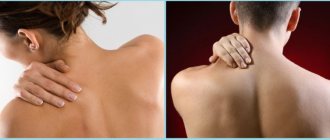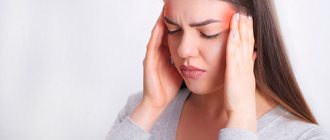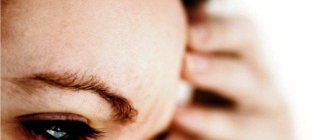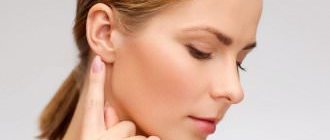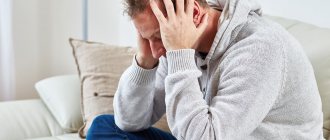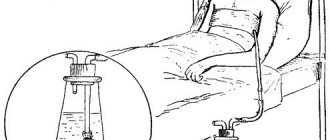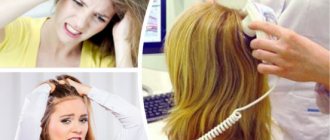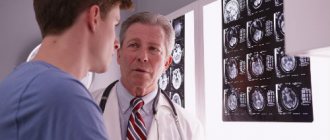When patients complain that the hair roots on their scalp hurt, we are, of course, not talking about the strands themselves, but about the scalp, which may be damaged, compressed or inflamed. Be that as it may, this symptom signals the need for an early trichological examination.
What to do if the skin at the hair roots hurts
If you feel that your hair roots are hurting, you should contact a trichologist as soon as possible. The specialist will carefully examine the hair shafts and scalp, and then prescribe the necessary diagnostic techniques that will help identify the cause of the discomfort.
Depending on what exactly led to the pain, the following may be recommended:
- sebum-regulating drugs;
- antifungal, anti-inflammatory, antibacterial agents;
- medicated shampoos, masks and balms, selected in accordance with the diagnosis and individual characteristics of the body;
- vitamin complexes.
The following procedures will help speed up the process of scalp restoration, as well as strengthen the strands and improve their structure:
- head massage;
- peelings;
- mesotherapy;
- biorevitalization;
- plasma therapy;
- ultrasound and infrared light treatment;
- laser therapy, etc.
The required number of procedures, as well as the optimal intervals between them, will be determined by a specialist. As a rule, positive results are noticeable after the first sessions. Of course, it is important not to forget about proper home hair care. In particular it is recommended:
- give up tight hairstyles;
- dry your strands naturally (or at least without using a hot hair dryer);
- use only hair care products selected by a trichologist;
- wear loose hats made from natural materials.
In addition, it is important to eat properly, maintain a drinking regime, and, if possible, minimize any stressful effects.
Inflammatory disease of the scalp
03.02.2021
Seborrhea is an inflammatory disease of the scalp. With this disease, the volume of sebum and its composition increase. The disease is manifested by itching, peeling and thickness of the stratum corneum. The scalp also becomes inflamed, red, swollen and constantly itchy.
Causes
There is no main cause for this disease. The disease can occur due to genetics, metabolic disorders, and also under unfavorable environmental conditions. Often this disease appears due to reasons such as:
- violation of the hormonal state of the body;
- pathologies of the endocrine system .
The main component of this disease is a yeast-like fungus that lives in a large number of people. The number of these fungi can increase sharply under the influence of unfavorable environmental factors.
Symptoms
The main symptoms of this disease are: flaking of the scalp, inflammation, itching and burning. If this disease is neglected and you do not consult a specialist for a long time, it can appear on the forehead, eyelashes, eyelids and eyebrows.
With dry seborrhea, small white scales appear, which are accompanied by severe itching. This type of disease is quite easy to diagnose and treat. If you don't wash your hair for a long time, the disease can begin to spread to new areas of the body.
Diagnosis and treatment
Trichologists diagnose and treat this disease . First you need to determine the cause of this disease. At the same time, hormones , gastrointestinal tract, as well as the state of immunodeficiency are checked.
Antifungal agents are used to treat this disease. They are more effective than anti-inflammatory drugs. Also, during treatment, it is necessary to adhere to a strict diet, which includes: avoiding fatty, fried, sweet and salty foods, as well as eating foods rich in fiber, vitamin B and zinc. To improve the scalp and hair, it is necessary to use vitamins and vitamin complexes containing brewer's yeast.
In severe cases of this disease, keratolytic drugs are prescribed. The scales can be softened using natural oils or petroleum jelly. Next, you need to smear the scalp with antifungal drugs. If this type of therapy is ineffective, then drugs containing hormones .
Also, for this disease, the patient is prescribed scalp massage cryomassage ) and stimulation of hair growth (darsonvalization).
After treatment for this disease, the patient will have to use medicated shampoos for some time to prevent relapse of the disease. Subsequently, such shampoos are used about twice a month for prevention.
To prevent complications and serious consequences of this disease, it is necessary to promptly seek help from a specialist. The prognosis for seborrhea is quite favorable. The disease is treated relatively quickly.
Published in Dermatology Premium Clinic
Causes of pain in the occipital region of the head. Self help
Often, we rarely run to the doctor if something doesn’t hurt us too much; we only decide to visit an aesculapian when it’s already too hot. When experiencing pain in any part of the body, we sometimes do not even suspect that the cause of pain in one place may be the ill health of a completely different organ. This is what we will talk about today.
The most common causes of neck pain
Spine.
The presence of diseases of the spine in the cervical region, such as spondylosis, osteochondrosis, neck dislocations, spondylitis, can cause pain in the back of the head. Head movements are accompanied by neck pain.
Mental stress.
Stress is the main cause of a nervous state, and, accordingly, occipital pain. People, especially women, over 25 years of age should beware of stress, as they are at risk.
Overstrain of a physical and mental nature.
Excessive stress on the cervical spine also often causes discomfort in the back of the head. However, overstrain can also be mental. Concentrating on something, staying in one position for a long time, or an uncomfortable position also has unpleasant consequences.
High blood pressure.
This is the case when you need to see a doctor as soon as possible. The first sign of this condition is constant headaches in the back of the head in the morning.
Poor blood circulation in the muscles.
Poor blood circulation in the neck muscles leads to the appearance of compactions in them, which is called myogelosis. The reasons for its appearance are:
- stress;
- drafts;
- staying in one position for a long time and, as a result, muscle stiffness;
- problems with posture.
In this case, occipital pain is not the only sign of the disease. Dizziness, pain in the shoulders, and difficulty moving also appear.
Problems with peripheral nerves.
Neuralgia is the most common cause of pain. If you have neuralgia, a person also experiences pain in the jaw, neck, back, and ear. It hurts the patient to even cough or sneeze. In order to avoid the development of hypertension, you need to consult a specialist in time.
Migraine.
Migraine occurs not only in the head, but also in the neck. The pain, in this case, affects not only the back of the head, but also the temples. There may also be pain in the eyes, dizziness, a feeling of a white veil before the eyes, and hearing loss may develop.
Poor blood circulation in the brain.
Due to disturbances in the circulatory system of the brain, its functioning deteriorates. In this case, a person may experience, in addition to pain in the back of the head, dizziness, a sensation of tinnitus, visual and hearing disturbances. In some cases, nausea, fainting, vomiting may occur, and coordination of movements may be impaired.
First aid
If right now you cannot visit a doctor, and the pain does not go away, then you need to know first-aid techniques in order to experience relief at least for a while.
- Massage. It is done on the neck, shoulders and back of the head. You can do it yourself, but it is not very convenient, so it is better to ask someone for help. The main thing is not to make sudden, strong movements, and when pressing on any areas, do not apply force. It is better to stretch it a little and stroke it with relaxing movements.
- Change your body position, stretch, do exercises and be sure to ventilate the room.
- It is allowed to take medications that relieve spasms. In some cases, medications are taken that reduce muscle tone. But you can do this only if you are sure that the cause of pain in the back of the head is precisely the tightened neck muscles.
When and which doctor should I contact?
Of course, it is undesirable to engage in self-diagnosis and self-medication, therefore, when the first signs of pain in the back of the head appear, it is better to consult a doctor in order to accurately determine their cause.
This problem is dealt with by specialists such as a traumatologist, a neurologist and a massage therapist.
First, visit a neurologist, and he will redirect you to the right specialist. Author: K.M.N., Academician of the Russian Academy of Medical Sciences M.A. Bobyr
What is trichodynia
Patients describe this condition in different ways, since everyone has their own nuances:
- a separate area of the scalp (usually the parietal area, crown) or one half of the head hurts
- soreness to touch or constant
- hair roots hurt
- skin itches, itches
- sensation of numbness, burning, tingling
- when touched, pain shoots into the ear
- there is an increase in temperature
- loss has increased
- accompanied by depression, anxiety disorders
- dilated blood vessels (telangiectasia) can be found on the scalp
The presence of certain symptoms provides clues as to what is causing the condition. But the true cause is sometimes impossible to establish, because this phenomenon has not yet been sufficiently studied. The fact is that the skin of the scalp has a complex dense network of nerves and blood vessels.
Sometimes pain occurs temporarily, you can associate it with something (unusual hairstyle, new shampoo, coloring), you can alleviate it.
If this condition lasts continuously for a long time, then we are talking about a chronic skin sensory disorder.
Currently, trichodynia is associated with:
- perifollicular inflammation (tissues around hair follicles). The biopsy actually reveals microinflammation around the follicles.
- increased secretion of the neuropeptide - substance P. This substance dilates blood vessels, increases pain sensitivity and inflammation, and is released during emotional stress and other irritating factors.
- deficiency of B vitamins (especially B12), which are neuroprotectors (means that protect brain neurons from damage).
- There has also been a connection with mental disorders and disorders of the nervous system.
Unpleasant painful sensations occur more often in women than in men. This may be due to greater emotional lability and anxiety, which cause a lower pain threshold. Instability of the nervous system leads to vascular spasms, which can be painful, and also provokes prolapse.
